

Army Ant
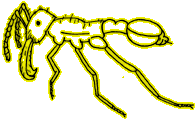 Over 200 different kinds of army ants exist in the world. They live in huge colonies and, unlike other ants, have
no fixed nests. Instead, they are nomadic, moving into different areas of the
forest during "raids," killing, dismembering, and bringing to
temporary homes (called "bivouacs") any animals that couldn't escape
them. Like other social insects (i.e., ants, termites, and
honeybees), there are several different groups of army ants in a colony, headed
by a single, large, fertile female, the queen. She has no wings and produces
vast quantities of eggs, which are cared for by other members of the colony.
Every 30-40 days or so, the colony gathers in a large swarm. The queen then lays
up to as many as 30,000 or more eggs in two days. Male army ants are few in
number and have wings; they periodically leave the colony to search for other
queens. The majority of the 80,000 or so army ants in an average-sized colony
are sterile females. These ants are generally either workers or soldiers.
Soldiers are about twice the size of workers, with enlarged heads and jaws. The many ants working together as a coordinated army
function as a kind of forest "super-predator." They mainly hunt on the
forest floor, killing other insects, small lizards, and small mammals, but they
will also climb trees, killing tree insects, baby birds in their nests, etc.
Because the ants move relatively slowly, most large or fast-moving animals are
able to escape them.
Over 200 different kinds of army ants exist in the world. They live in huge colonies and, unlike other ants, have
no fixed nests. Instead, they are nomadic, moving into different areas of the
forest during "raids," killing, dismembering, and bringing to
temporary homes (called "bivouacs") any animals that couldn't escape
them. Like other social insects (i.e., ants, termites, and
honeybees), there are several different groups of army ants in a colony, headed
by a single, large, fertile female, the queen. She has no wings and produces
vast quantities of eggs, which are cared for by other members of the colony.
Every 30-40 days or so, the colony gathers in a large swarm. The queen then lays
up to as many as 30,000 or more eggs in two days. Male army ants are few in
number and have wings; they periodically leave the colony to search for other
queens. The majority of the 80,000 or so army ants in an average-sized colony
are sterile females. These ants are generally either workers or soldiers.
Soldiers are about twice the size of workers, with enlarged heads and jaws. The many ants working together as a coordinated army
function as a kind of forest "super-predator." They mainly hunt on the
forest floor, killing other insects, small lizards, and small mammals, but they
will also climb trees, killing tree insects, baby birds in their nests, etc.
Because the ants move relatively slowly, most large or fast-moving animals are
able to escape them.
Azteca Ant

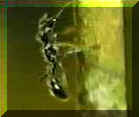 These ants tend to live only in the hollow stems of cecropia trees, an example
of an ant-plant association. They are aggressive and are especially active at
the tips of growing branches, but they lack the painful bites or effective
stings characteristic of other Amazon ants like army ants or fire ants.
These ants tend to live only in the hollow stems of cecropia trees, an example
of an ant-plant association. They are aggressive and are especially active at
the tips of growing branches, but they lack the painful bites or effective
stings characteristic of other Amazon ants like army ants or fire ants.
The ants feed off protein-rich secretions, necessary in
their diet, that are produced by special glands at the base of the leaves. The
ants do not sting, but they do bite, and will fiercely protect the tree from
potential dangers. They attack other insects that land on the tree and drive
them away. They will cut and kill any vines that begin to climb up the tree.
Whereas many other trees in the rain forest will be covered in epiphytes or
dripping with vines, cecropia trees are generally epiphyte-free and vine-free. These
actions of the azteca ants allow the cecropia tree to stay healthy, grow as fast
as possible, and successfully compete with other trees for limited sunlight; in
return, the tree provides the protecting ant with a place to live and a source
of food. Azteca ant colonies seem to be a favorite food of the tamandua.
Morpho Butterfly
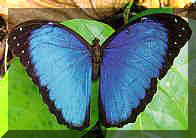 The morpho is a large butterfly with brilliant, shimmering blue wings. Pilots flying over the Amazon can observe their shining
wings fluttering below in the canopy.
The morphos・ brilliant color assists in attracting mates, but also makes them
noticeable to predators, especially in sunlight. However, morphos are quick,
agile fliers and are difficult to catch, and they seem to disappear when they
enter shade. Blue morphos can mask their signature iridescence by just closing
their wings. Morphos also use camouflage to blend in with their surroundings:
below their blue brilliance, their undersides are the colors of leaves and bark.
The morpho is a large butterfly with brilliant, shimmering blue wings. Pilots flying over the Amazon can observe their shining
wings fluttering below in the canopy.
The morphos・ brilliant color assists in attracting mates, but also makes them
noticeable to predators, especially in sunlight. However, morphos are quick,
agile fliers and are difficult to catch, and they seem to disappear when they
enter shade. Blue morphos can mask their signature iridescence by just closing
their wings. Morphos also use camouflage to blend in with their surroundings:
below their blue brilliance, their undersides are the colors of leaves and bark.
Morphos spend much of their time in the forest canopy,
often found around streams and sunlit areas. Adults feed on nectar and
fermenting fruit and assist in flower pollination; caterpillars feed on leaves.
Both adults and caterpillars are eaten by birds, spiders, and other
insect-eaters.
Giant Damselfly

 A very large insect (females have a 10 cm long abdomen), the giant damselfly has
one of the biggest wingspans (17 cm) of any insect. Its wings are transparent
except for blue-purple bands or a splash of color at the tips. The males flutter in sunny forest clearings to attract
females. The females fly high into the canopy and deposit their eggs in tank
bromeliad pools. The eggs hatch into predatory larvae that eat other occupants
of the pool, including bromeliad frog tadpoles. With their large eyes, adult damselflies are efficient predators, capturing
other flying insects in flight, snatching insects already trapped in spider
webs, or catching the spider as well.
A very large insect (females have a 10 cm long abdomen), the giant damselfly has
one of the biggest wingspans (17 cm) of any insect. Its wings are transparent
except for blue-purple bands or a splash of color at the tips. The males flutter in sunny forest clearings to attract
females. The females fly high into the canopy and deposit their eggs in tank
bromeliad pools. The eggs hatch into predatory larvae that eat other occupants
of the pool, including bromeliad frog tadpoles. With their large eyes, adult damselflies are efficient predators, capturing
other flying insects in flight, snatching insects already trapped in spider
webs, or catching the spider as well.
Leaf-cutter Ant
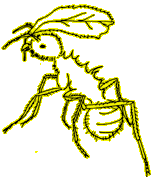
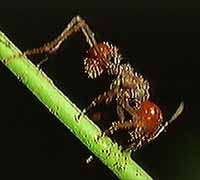 With their scissor-like jaws, leaf-cutter ants carve out crescent-shaped pieces
of leaves, which they then carry back to their underground nests. The leaf bits
are carried above their heads like green umbrellas, giving them the nickname
:parasol ants.; There are fourteen different species of leaf-cutter ants in
the Amazon. The ants will select only certain trees, or cut only
young leaves or old leaves, or green fruits; sometimes they cut only flowers.
Their choice may be related to the presence of toxic chemicals in the leaves.
Many tropical plants have evolved such poisonous or distasteful chemicals as an
adaptation to protect themselves from leaf-eating organisms.
The ants do not feed on the leaves directly; instead, the crushed leaves are
used to grow a special fungus in certain of the underground chambers, which is
then eaten by the ants. Some biologists believe that leaf-cutting ants are the
Amazon's major herbivores, damaging more leaves than any other leaf-eater. Ants
and termites as a collective group make up about 30% of the animal biomass in a
tropical rain forest. Ants are social insects, and leaf-cutter ants have one
of the most complex social organizations. They are organized by a division of
labor. The queen lays the eggs, so the growth of the colony is dependent on her.
The :workers; are the labor force, with specific tasks according to size and
age. The very small ants take care of the fungus. The bigger ones that are
strong enough cut the leaves. And then there are the soldiers. They cut only the
very tough leaves, but mostly they・re involved in mass defense. If an enemy
invades their nest, thousands of soldiers go outside the nest to defend the
colony. Many of them die, but the nest is saved.The leaf cutter ants are one of the first life forms on earth to
engage in a form of agriculture. They use the leaves to form an organic
mulch that nurtures the growth of a certain type of mushroom, which the
ants cultivate and eat as their sole diet. Brings a whole new meaning to
the words "ant farm."
With their scissor-like jaws, leaf-cutter ants carve out crescent-shaped pieces
of leaves, which they then carry back to their underground nests. The leaf bits
are carried above their heads like green umbrellas, giving them the nickname
:parasol ants.; There are fourteen different species of leaf-cutter ants in
the Amazon. The ants will select only certain trees, or cut only
young leaves or old leaves, or green fruits; sometimes they cut only flowers.
Their choice may be related to the presence of toxic chemicals in the leaves.
Many tropical plants have evolved such poisonous or distasteful chemicals as an
adaptation to protect themselves from leaf-eating organisms.
The ants do not feed on the leaves directly; instead, the crushed leaves are
used to grow a special fungus in certain of the underground chambers, which is
then eaten by the ants. Some biologists believe that leaf-cutting ants are the
Amazon's major herbivores, damaging more leaves than any other leaf-eater. Ants
and termites as a collective group make up about 30% of the animal biomass in a
tropical rain forest. Ants are social insects, and leaf-cutter ants have one
of the most complex social organizations. They are organized by a division of
labor. The queen lays the eggs, so the growth of the colony is dependent on her.
The :workers; are the labor force, with specific tasks according to size and
age. The very small ants take care of the fungus. The bigger ones that are
strong enough cut the leaves. And then there are the soldiers. They cut only the
very tough leaves, but mostly they・re involved in mass defense. If an enemy
invades their nest, thousands of soldiers go outside the nest to defend the
colony. Many of them die, but the nest is saved.The leaf cutter ants are one of the first life forms on earth to
engage in a form of agriculture. They use the leaves to form an organic
mulch that nurtures the growth of a certain type of mushroom, which the
ants cultivate and eat as their sole diet. Brings a whole new meaning to
the words "ant farm."

Orchid Bee
Male orchid bees feed on nectar from flowers like the gongora orchid, and in the process of nectar-gathering they pick up pollen which they carry to other orchids, thus serving as agents of pollination. In the tropics, insects (such as orchid bees) and birds are the two most important pollinators, probably assisting pollination in more than half of all plants. The nectar that they collect is stored in hollow cavities in their hind legs. The males, attracted to each other by the powerful scent of the nectar, gather in all-male swarms. These all-male swarms function as an attractive display to female orchid bees. Thus, the orchid's nectar not only nourishes the bee, but is necessary for the bee's courtship ritual and its successful reproduction.
Parasitic Fly
There are many species of parasitic flies and wasps in the rain forest that can only survive by reproducing on another specific kind of insect host. By so doing they help to control population explosions of such insects. This fly, the leaf-cutter ant parasitic fly, lays its eggs only on the backs of leaf-cutter ants. Usually, the large worker leaf-cutter ants that cut and carry the leaves back to the nest are protected both by soldier leaf-cutters with huge jaws and by smaller worker leaf-cutters that remain close by or "hitchhike" on the piece of leaf. These smaller workers chase away potential predators like the fly. The fly circles the worker ants, attempting to get close enough to deposit an egg and fly away; the smaller worker ants prevent it from getting too close. However, if the large worker leaf-cutter is left unguarded, it can have an egg deposited on its back by the fly. The fly larva that hatches from the egg burrows into the ant, eventually killing it. The larva finally develops into an adult fly, having lived off the body of the ant. Both the ant and the fly, in turn, can be eaten by other ants or by larger insect-eating animals, such as antbirds or anteaters.
Sloth Moth
On those infrequent occasions when the three-toed sloth climbs down to the base of its tree to deposit dung, sloth moths fly out of the sloth's fur. The female moths lay their eggs in the pile of sloth dung pellets. The moth larvae hatch and feed on material (e.g. undigested plant remains, etc.) in the dung or nearby plants. When they become adult moths, they fly up into the canopy and find a sloth in whose hair they live and hide. There are 3 species of sloth moth, found only on three-toed and two-toed sloths. They are about one-third inch long with flattened bodies, and can move easily through the sloth's dense hair. The moths are preyed upon (both as larvae and as adults) by a wide variety of insect-eating animals such as predatory ants, antbirds, etc. The adult moths do not seem to feed on the sloth's hair. Any advantages to the sloth of the moths・ presence are unknown.
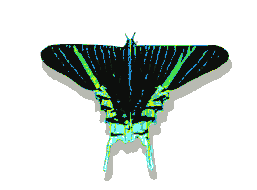 Uranus Moth
Uranus Moth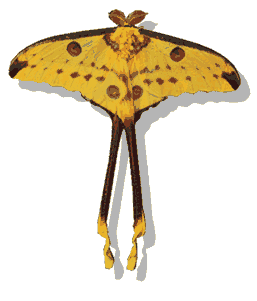 Comet Moth
Comet Moth
Bombardier Beetle
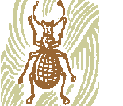 The Bombardier Beetle uses hydrogen peroxide and other chemicals
stored in its glands to create a jet blast of boiling hot irritating
chemicals to ward off its enemies. It's like a walking bottle of pepper
spray.
The Bombardier Beetle uses hydrogen peroxide and other chemicals
stored in its glands to create a jet blast of boiling hot irritating
chemicals to ward off its enemies. It's like a walking bottle of pepper
spray.